Europe’s under-the-radar region that’s home to the ‘undisputed tea world champions’
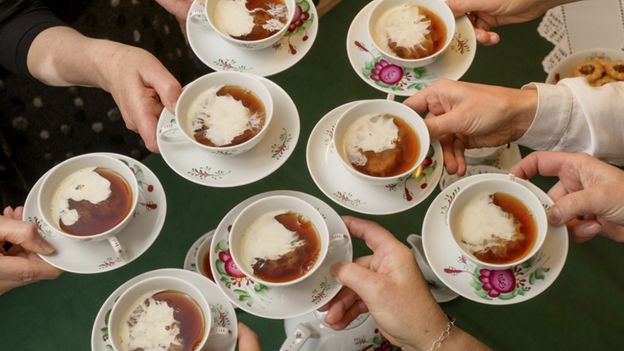
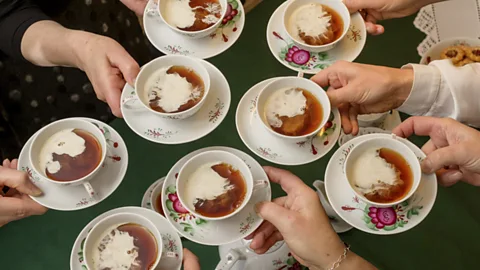 Bünting Tea Museum
Bünting Tea MuseumThe world’s most prolific tea drinkers are not in the UK or in Ireland, but in a little-known German region that has developed a unique and fascinating tradition.
In Germany’s flat and sparsely populated north-western corner, a region known as East Frisia, an old tradition has helped locals set an unusual record. Here they drink, on average, more tea than anyone else in the world.
The Hamburg-based association describes East Frisians as “undisputed tea world champions“. It notes that not only do they drink far more than the German average, but they surpass consumption in other tea-drinking cultures around the world – a record certified by the German Records Institute in 2021 after comparing German statistics with international ones from the International Tea Committee in London.
One East Frisian who can proudly talk about her region’s unique tea tradition is Celia Brandenburger, who was raised in East Frisia and is the director of the local tea museum in Leer, a quiet town of cobbled streets close to the Dutch border. For her, the black tea served in a small porcelain cup decorated with an elaborate rose blossom is much more than just a beverage that warms her on a cold, grey morning. Rather, she says, tea is brewed to create a unique atmosphere. It’s a tea ceremony for all the senses.
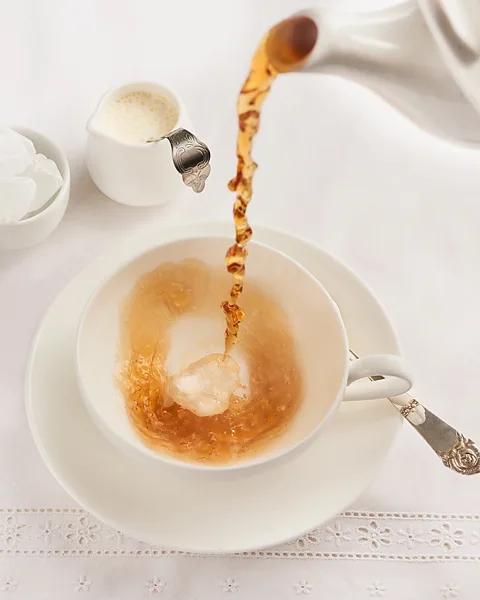 Teeverband
TeeverbandTo begin the ceremony, Brandenburger put a piece of rock sugar – or Kluntje – in the bottom of a cup. As she poured the tea, it produced a strong aroma followed by a soft, crackling sound as it hit the sugar. She then scooped some thick cream onto a silver spoon and circled the cup’s inner rim, letting the cream gently slide in. She did this anti-clockwise, “so as to stop the passing of time”.
What came next was a blink-and-you’ll-miss-it spectacle: the cream sank to the bottom but then quickly bubbled up, creating an effect that locals call “Wulkje“, which means small clouds. These clouds slowly came together and formed a white layer of cream, which is meant to remain on the surface. The tea must not be stirred, Brandenburger warned, so that it can be tasted in three phases.
Where to try East Frisian tea
– Learn about the history of East Frisian tea at the two regional museums: The Bünting Tea Museum in Leer and the East Frisian Tea Museum in Norden. Here, you can also take part in a traditional East Frisian tea ceremony.
The first sip tastes mostly of the thick cream; the second highlights the strong black tea; and the final one is a sweet note of the dissipating rock sugar. These three phases are then repeated as East Frisians normally drink at least three cups at a time. The host always pours the tea and only stops when a person discreetly places a spoon in an empty cup.
“This tea ceremony really marks our identity,” said Brandenburger. “It’s something that unites East Frisians. East Frisians are rather individualistic, but when it comes to tea, they usually agree.”
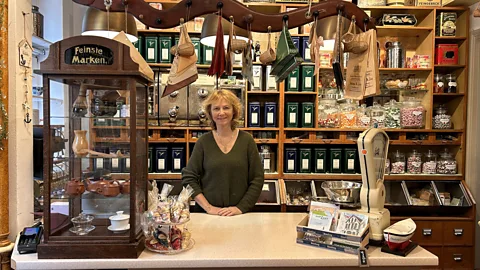 Thomas Sparrow
Thomas SparrowTea as intangible cultural heritage
Tea drinking starts early in East Frisia. Brandenburger says she’s even demonstrated a tea ceremony process at a daycare centre. And she remembers when her own children, still sitting in high chairs, received their first spoonful of black tea as their grandparents eagerly awaited their reaction.
“When you grow up here, drinking tea constantly is the most normal thing,” she said. “It starts with tea for breakfast. There is tea in the morning, there is tea in the afternoon. Many East Frisians also drink tea before they go to bed. So tea time is, easily, about four or five times a day.”
East Frisia’s tea is a mixture of black teas, mostly Assam, and it plays such a significant role for the region that it was formally inscribed in 2016 as part of Germany’s intangible cultural heritage. Tea is served in tea houses, advertised on the streets, promoted as a tourist attraction, and even serves as inspiration for artists. In Leer, there’s a full-size bronze statue of a woman carrying a cup and a teapot.
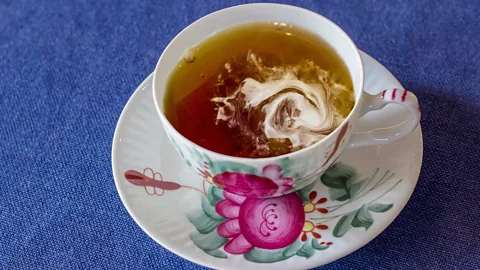 East Frisian Tea Museum
East Frisian Tea MuseumEast Frisian tea is also the main feature of not one but two regional museums: the one Brandenburger works at in Leer, and another museum further north, in the town of Norden.
Mirjana Culibrk is the museum director in Norden. An avid traveller, the former archaeologist says she’s fascinated by the world’s different tea cultures. For her, East Frisian tea is special due to the extensive ceremony around the tradition. “No East Frisian would just take a cup and throw in a tea bag and then say that’s the East Frisian tea culture,” she said.
A symbol of East Frisia
Brandenburger explained that in the middle of the 17th Century, tea was reserved mostly for wealthy East Frisians. It was not until the British began to cultivate tea in the Indian region of Assam around 1850 that tea became cheaper and thus affordable for the entire population.
“It was probably only at this time that today’s East Frisian tea ceremony came into being,” she said.
What also contributed to East Frisian tea culture is what historian Martin Krieger describes as a movement to strengthen regional German identities in the final decades of the 19th Century.
Krieger, a professor of northern European history at the University of Kiel and author of a book about the history of tea, says people in different places used to enjoy tea in a similar way – with rock sugar or cream, for example – but this movement meant that East Frisians took the basic tea-drinking method “and claimed this traditional preparation for themselves”.
 East Frisian Tea Museum
East Frisian Tea MuseumMajor East Frisian tea trading companies also began to operate in the 19th Century. Bünting was founded in Leer in 1806; Thiele was established in the city of Emden in 1873; and Onno Behrends was founded in Norden in 1887.
The three brands, which are still active, developed their tea mixtures, and in the 1930s began to use the term “genuine East Frisian blend”. Today, East Frisian tea can only be called genuine if it is mixed by companies in the region.
Strong, malty and aromatic
At the East Frisian Tea Association, tea taster Stefan Feldbusch is in charge of buying and tasting the different teas that will ultimately form the East Frisian mixture. Several times a year, he and his team sample different teas until they get the right combination.
They let 2.86g of tea – the weight of an old British sixpence – brew for five minutes in boiling water, and then they analyse the results. Their goal is to ensure that the taste, the aroma and even the colour of East Frisian tea remain consistent.
“East Frisians value good quality,” Feldbusch said. “And by good quality I mean that the tea must be strong, malty and aromatic. And since they drink it with cream and rock sugar, the tea, together with the cream, must produce a beautiful, bright, shining colour.”
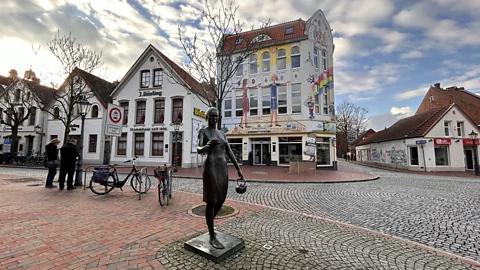 Thomas Sparrow
Thomas SparrowThese qualities are not only key for Feldbusch and his team of tea tasters. They’re also important for tea enthusiasts like Brandenburger and Culibrk, or for any local enjoying an East Frisian cup at home or in a tea house. This search for a good colour, an ideal aroma and a consistent taste speaks to the strength of East Frisian identity and the distinct tea ceremony that locals enjoy with all their senses.
As Brandenburger said: “Every East Frisian would tell you that it is a piece of home.”
BBC.com’s World’s Table “smashes the kitchen ceiling” by changing the way the world thinks about food, through the past, present and future.
Related
A New Book Argues That What Happens in Europe Doesn’t…
Remaking the World: European Distinctiveness and the Transformation of Politics, Culture, and the Economy by Jerrold Seigel “No issue in world
Poland plans military training for every adult male amid growing…
Poland’s prime minister, Donald Tusk, has said his government is working on a plan to prepare large-scale military training for every adult male in response t
2025 European Athletics Indoor Championships: Ditaji Kambundji secures women’s 60m…
Switzerland’s Ditaji Kambundji walked away from the 2025 European Athletics Indoor Championships in Apeldoorn on 7 March with much more than her first Europea
Takeaways from the EU’s landmark security summit after Trump said…
BRUSSELS (AP) — European Union leaders are trumpeting their endorsement of a plan to free up hundreds of billions of









